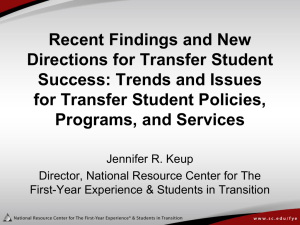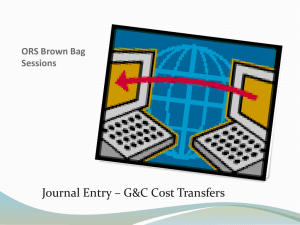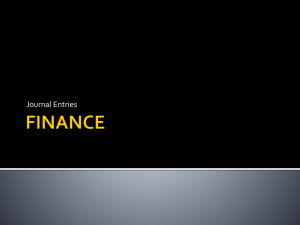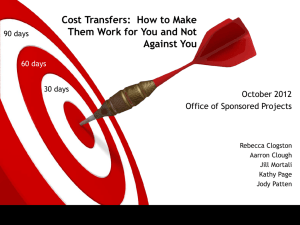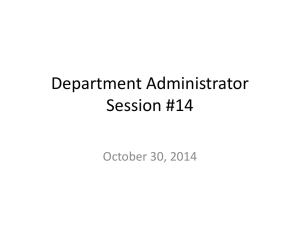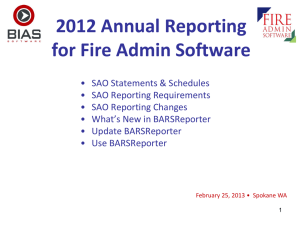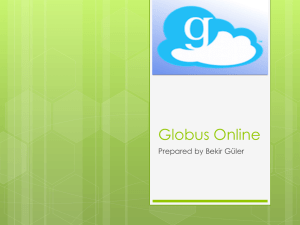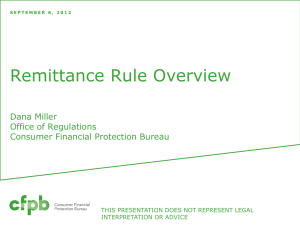Cost Transfers - University of Colorado Denver
advertisement
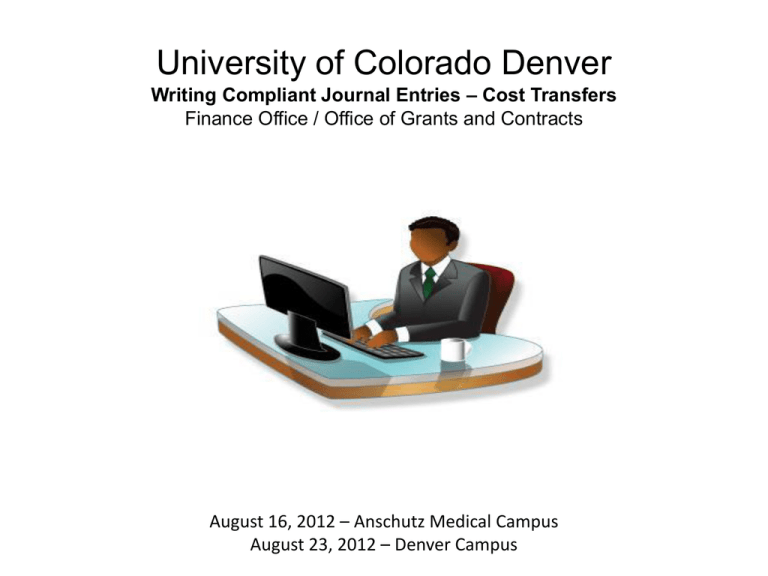
University of Colorado Denver Writing Compliant Journal Entries – Cost Transfers Finance Office / Office of Grants and Contracts August 16, 2012 – Anschutz Medical Campus August 23, 2012 – Denver Campus Background An audit was conducted by Internal Audit over Cost Transfers & Journal Entry Descriptions. Definition: A cost transfer is a transfer of expenditures to and/or from a sponsored project by means of a journal entry. Audit Objective: Ensure cost transfers comply with applicable university, state and federal requirements. Audit Findings - Topics: 1. Cost Transfers on Projects in Deficit Status 2. Inadequate Journal Entry Descriptions 3. Untimely Cost Transfers 4. Incomplete, Insufficient or Illegible Supporting Documentation Finance Office Slide 2 Cost Transfer on Projects in Deficit Status Guidance: • National Institutes of Health (NIH) Grants Policy Statement, Part II: Terms and Conditions of NIH Grant Awards - Subpart A – 7.5 Cost Transfers, Overruns, and Accelerated and Delayed Expenditures states: “Transfers of costs from one project to another or from one competitive segment to the next solely to cover cost overruns are not allowable.” • Campus guidance Cost Transfers on Sponsored Projects, 4-12 also refers to the NIH Grants Policy. • Health and Human Services (HHS) Grants Policy Statement II-43, Cost Transfers states that transferring costs due to a deficit generally is not allowable. Finance Office Slide 3 Cost Transfer on Projects in Deficit Status Finding: • Journal entry description and the supporting documentation did not clearly support or explain why the transfer should be charged to the new speedtype. If new speedtype is another project, why this expense was necessary to complete the scope of work for the new speedtype. • Transfer was from a National Science Foundation (NSF)-sponsored project to a NIH-sponsored project. Because the validity of the transfer was not adequately explained, it was not possible to determine whether the charge was allowable, allocable, reasonable, or consistent. Finance Office Slide 4 Inadequate Journal Entry Descriptions Guidance: • The Cost Transfer Policy requires the “long description” on the journal entry to include the cause of the error and how/why is the expense necessary to complete the scope of work of the project charged. • Without adequate journal entry descriptions, OGC may not be able to determine whether the cost transfer is allowable, allocable, reasonable, consistent, and timely. Finding: • There were cost transfers that did not contain an adequate journal entry description as required by the policy Finance Office Slide 5 Long Description Finance Office Example #1 Inadequate Description Identified by Internal Audit: “To transfer income/expenses from HRSA grant” Suggested Description: “To transfer salary expenses from HRSA sponsored project (ST 63054321) that is over budget due to personnel costs being greater than planned. Expenses transferred to an allowable unrestricted departmental funding source (ST62612345). Finance Office Slide 7 Example #2 Inadequate Description Identified by Internal Audit: “To redistribute expenses in order to close out and balance speedtypes” Suggested Descriptions: “To Transfer expenses from Adolescent Research (ST 6306789) to Adolescent Research (new segment and new ST 63010293). Expenses were incurred during budget period of new segment, but purchase was not updated to new speedtype.” Finance Office Slide 8 Example #3 Inadequate Description Identified by Internal Audit: “To move lab supplies from one speedtype to the new project speedtype where they should’ve been reported” Suggested Description: “To transfer lab supplies from ST6302223 NIH training grant to ST63033345. Lab supplies were required by ST63033345 in order to complete INUITRO studies for the grant. Expenses were originally booked wrong due to a miscommunication in lab order request” Finance Office Slide 9 Untimely Cost Transfers Guidance: • The Cost Transfer Policy requires cost transfers to “happen immediately on the discovery of an error or as soon as possible, but not more than 90 days after the discovery of the error” • 90-day timeframe is also in agreement with NIH and HHS guidance • Untimely cost transfers could be disallowed and can have consequences on financial statements and/or the project closeout process • Re-submitting financial reports are often looked upon negatively by the sponsor because (1) of the rework it cause the sponsor and (2) potential internal control weaknesses this suggests to the sponsor. Often, the sponsor will reject the re-submission. . Finance Office Slide 10 Untimely Cost Transfers Finding: • Cost transfer tested did not occur in a timely manner. • The need for the transfer to properly account for a change in primary awardee was first documented in June 2009 but the transfer did not occur until January 2011. Finance Office Slide 11 Incomplete, Insufficient or Illegible Supporting Documentation Guidance: • The Cost Transfer Policy requires transfers to be: “clearly supportable” and “supported by documentation that contains a full explanation of how the error occurred and a certification of correctness of the new charge by a responsible CU Denver organizational official” • The policy further explains that sufficient supporting documentation will “promote understanding of why the JE is required, including how and/or why the error was made; why it is appropriate to charge the expenses to the project referenced in the JE; and assurance that the charges are reasonable, allowable, allocable, and in accordance with award terms” • The documentation requirement is also in agreement with NIH and HHS guidance • Without complete, sufficient, and legible supporting documentation, OGC may not be able to determine whether the cost transfer is allowable, allocable, reasonable, consistent, and timely. Finance Office Slide 12 Incomplete, Insufficient or Illegible Supporting Documentation Finding: • Cost transfers tested did not have complete or sufficient supporting documentation. • One cost transfer had an illegible report as supporting documentation. Finance Office Slide 13 Examples – Incomplete/Insufficient Supporting Documentation • Supporting documentation doesn’t indicate how the $ amount transferred was arrived at • Incomplete because there were Invoices to support most of the journal lines but not all. • Unclear how the supporting documentation and the cost transfer relate • The supporting documentation was an expense report with numbers highlighted that add up to the number transferred; no other explanation of who determined the numbers highlighted or why they were determined to be transferred was included Finance Office Slide 14 Example – Illegible Supporting Documentation Additional Items • JEs create additional work & weaken internal controls. It’s best if booked (or allocated) appropriately @ point of purchase • Have method for communicating new speedtype for same award in Lab • Defendable basis for allocation of commonly used supplies purchased in bulk or shared by multiple projects • Example of Allocation Basis: – Based on FTE on each project – Based on proportion of budgeted expenses – if budgeted supplies based on bottom up usage estimate. Finance Office Slide 16 Resources o Processing a journal entry – Guidance http://www.ucdenver.edu/about/departments/finance/Documents/Financ eFiles/Processing_Actual_JE.pdf o Finance Contacts • Shaun McMullin, Deputy Controller Shaun.McMullin@ucdenver.edu or 303-315-2270 • Ryan Yu, Associate Director of Accounting Services Ryan.Yu@ucdenver.edu or 303-315-2256 • Caroline Kirkwood, Financial Compliance Auditor Caroline.Kirkwood@ucdenver.edu or 303-315-2286 o Office of Grants & Contracts • Post Award Administrator Finance Office Slide 17 Conclusion Items to Remember: • Journal entry description should clearly support and explain how the error occurred, the appropriateness of the transfer and why the expenses were necessary to complete the scope of work – direct relationship to scope of work is key • PeopleSoft allows 254 characters in the long description • Timely booking of cost transfer w/in 90 days after discovery of error • Complete and sufficient supporting documentation Finance Office Slide 18 Questions? Finance Office Slide 19


